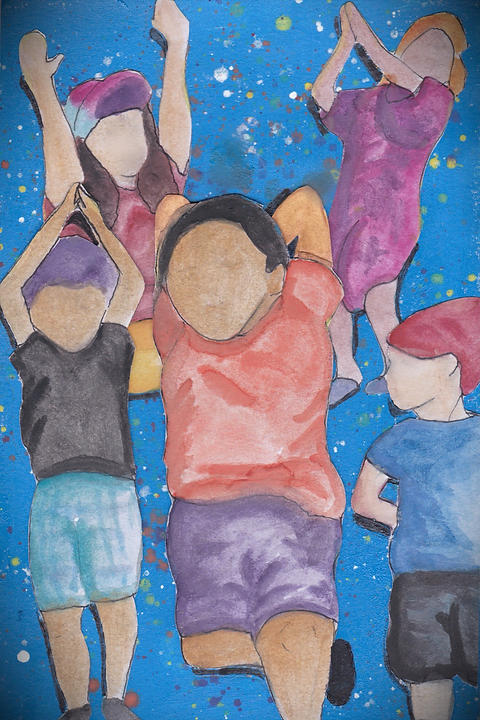
CONDUCTING CHAOS
Conducting Chaos: Teaching Improv to Children and Teens is now for sale through Amazon, Kindle and independent bookstores.
"Jessica Arjet is the ultimate source for child/youth improv with advice cultivated over decades of experience. Each page is detailed with games and tips that will help readers be the most successful with our littlest make believers."
- Tina Jackson Owner, Bexar Stage (San Antonio, TX)
INTRODUCTION TO CONDUCTING CHAOS:
Introduction: Why Teach Improv to Kids?
In 2006 I had just graduated from three levels of improv at the Hideout Theatre in Austin. I was thrilled with all I had learned and with how improv had fundamentally shifted some of my personal paradigms and improved my life. I had learned about and begun to embrace being positive, accepting risk, and being in the moment. I had grown up in theater as a child and loved the stage, but there was something different and magical and – dare I say -- life-changing about improv.
At the time I was homeschooling my 11-year-old daughter, which involved us hanging out with lots of other kids around the same age. I started teaching them a game or two I’d learned in class and they really seemed to like it.
Based on that, I rented some space and began teaching an improv class for kids. I had been a drama teacher on and off for years, so this was a natural role for me. I advertised the class to the homeschool community and held the classes on Tuesday afternoons. I was grateful that the kids in my homeschool group all signed up, in addition to a few more kids I didn’t know.
The kids loved it and seemed to be really embracing the same concepts that I had found to be so life-changing. They seemed relieved to have a place where risk was expected and failure was a sign of playing hard. I could see the simple exercises helping them find the power of creativity. They gained in confidence and became more socially adept. It was a great class.
Even more students signed up for the second round of classes, and all the kids developed even more. I found that I LOVED teaching these kids and watching them struggle with -- and eventually embrace -- these beautiful concepts.
However, by this time I had taught them all the games I knew. At the end of the class run, I sat the kids down and said that I wouldn’t teach the class again, because I didn’t have anything to teach them. They all just stared at me with wide eyes.
“I don’t know anything else, guys,” I explained. By this time the eyes had started to look sad, and I began to panic.
I tried to explain. “If I taught another class, I’d just be figuring it out as we went along.”
“Okay, cool,” the kids said.
And that’s how I began developing an improv program for kids.
Over the years I‘ve seen dozens of kids grow and change through improv.
One child refused to even walk onstage and just watched the other kids play for the entire first semester. For the showcase, he sat with his parents and wouldn’t come near the stage. In the second semester, he tried the games and played briefly in the final showcase. In the third semester, he bounded into class and took over the stage. His parents were literally in tears when they saw his final performance. He is now a concert pianist and credits improv with his ability to play in front of other people.
Another child was going through a rough gender identity exploration. Playing the different characters and stories let them play with their identity in a low-stress setting. They said that, other than home, improv class was the only place they felt safe and they could be themself that day, no matter what self that was.
Two of our special-needs teens found their first friend ever in improv class.
And of course I’ve seen children grow and change in a more typical way, turning from gangly kids to poised and confident adults.
Probably my favorite comment was from a child I taught for six years: “Thanks to Miss Jessica, I’m a much less awkward teen than I would have been otherwise.”
Improv helps kids through the difficult process of growing up. It helps them explore different voices and identities in a safe and fun environment. It teaches them how to work and create with others. It introduces a comfortability with risk so that when they make mistakes they can move on from them. And it creates a positive environment where students can use performance and creativity to process their complex and ever-changing lives.
I firmly believe that every child in the world should have at least a little experience with improv. That’s why I’m writing this book.
Also, improv classes make money! I always joke that The Hideout Theatre’s second-quarter profits are all thanks to me and summer camp. (Not only do I work there, but now I’m one of the owners.) Summer camp and youth classes may not make all of our profit, but they do make working in the arts a bit more sustainable.
Ultimately, though, the best reason to teach improv to kids is because it’s so much fun. What other job requires you to play silly games and laugh until your sides hurt while experiencing the joy of teaching your passion to the next generation? Improv is fun to learn, and even more fantastic to teach.